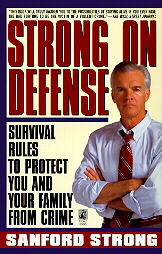
Strong on Defense

Buy the book (I do not get any cash for this)
At some point in the future I may write a detailed summary of this book, but for now, this book is highly recommended as a immediate read. It can save your life. Share it with your family and friends. Buy extra copies if possible. The lessons in it do not go out of date. It could dramatically change the outcome if you encounter violent crime. Mr. Strong, a veteran police officer, has provides an analysis of violent crimes backed by studies, statistics, and dozens of personal accounts from victims. He boils it all down to the essentials you need to know and do to survive. His method is proven again and again by the facts of life as seen by law enforcement.
Strong presents dozens of scenarios and talks about ways to survive them for all family members. The book exposes the myths of popular and common self defense techniques. His position is that attitude, not ability, is the path to survival and that men and women don’t differ in their needs or the ways in which they will survive. Crime happens fast and the common elements of crime can either be learned, prepared against, and defeated by us in victory, or it can make more common victims out of us all.
Strong stresses a survival "mind setting" against crime. He teaches that a person needs to picture himself in crime scenes and imagine their responses (and the likely results). People do this kind of thing every day for many other reasons. Strong urges us to practice and do the same sort of preparation in order to survive.
Decision making is a time consuming and difficult aspect of survival and time is one thing people have the least of in the midst of a crime. Mind setting allows you to make many decisions ahead of time and can help train you to react instinctively and appropriately without thinking (at a time when thinking becomes difficult). Strong outlines three important aspects to mind setting: picture yourself in the crime scene (not near it), picture your actions towards escape (be explosive), and picture being shot or stabbed (accept injury as a cost of survival).
To assist with our imagination, the book includes many first hand accounts of violent crimes. Strong follows these with comments on what the victims did wrong or right. The accounts span a large number of possible crime scenarios, from car jacking to road side abduction to home intrusion. Many of the accounts are graphic, and some involve violence to children.
Strong’s four rules to follow in training our minds against crime are:
React immediately – your best chance to escape violence and minimize injury is in the very first few seconds.
Resist – your only other alternative is to submit; both choices are lousy, but resisting gives you the best chance (and Strong proves this very well in the book). [Fear the criminal’s control of you more than his threats.]
Crime scene #2 – A criminal's control leads to disaster. Crime scene #2 is more isolated than the initial point of contact, and far worse for you.
Never, never give up – your attitude can keep you alive when you’re badly injured. This is a fact in times of war, and a war of resistance is exactly what it comes down to when resisting violent crime.
Strong gives clear advice on how intended actions enforce these rules, and clear advice on working with children and as a family to escape crime. Strong’s presentation is readable and direct. The anecdotes support the material well and help you train and internalize it as you read.
Review from Wall Street Journal, 07/03/1996: "Generally, Mr. Strong recommends three words--'immediate, direct, explosive'--as guidelines for resistance to violent attack. Don't wait; keep resisting and reacting with full force, and scream as loudly as you can. Screaming, he notes, helps to focus your mind, defends you against feeling pain and activates your strength. In the case of a mugging, he advises handing everything over and running for your life." -- Maria-Caroline Perignon